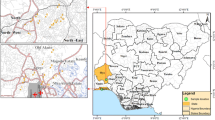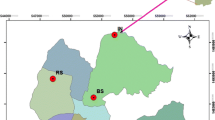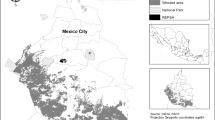Abstract
We present a modelling concept for evaluating the impacts of anthropogenic activities suspected to be from gas flaring on the quality of the atmosphere using domestic roof-harvested rainwater (DRHRW) as indicator. We analysed seven metals (Cu, Cd, Pb, Zn, Fe, Ca, and Mg) and six water quality parameters (acidity, PO43−, SO42−, NO3−, Cl−, and pH). These were used as input parameters in 12 sampling points from gas-flaring environments (Port Harcourt, Nigeria) using Ibadan as reference. We formulated the results of these input parameters into membership function fuzzy matrices based on four degrees of impact: extremely high, high, medium, and low, using regulatory limits as criteria. We generated indices that classified the degree of anthropogenic activity impact on the sites from the product membership function matrices and weight matrices, with investigated (gas-flaring) environment as between medium and high impact compared to those from reference (residential) environment that was classified as between low and medium impact. Major contaminants of concern found in the harvested rainwater were Pb and Cd. There is also the urgent need to stop gas-flaring activities in Port Harcourt area in particular and Niger Delta region of Nigeria in general, so as to minimise the untold health hazard that people living in the area are currently faced with. The fuzzy methodology presented has also indicated that the water cannot safely support potable uses and should not be consumed without purification due to the impact of anthropogenic activities in the area but may be useful for other domestic purposes.







Similar content being viewed by others
References
Adebowale KO, Agunbiade FO, Olu-Owolabi BI (2008) Fuzzy comprehensive assessment of metal contamination of water and sediments in Ondo estuary, Nigeria. Chem Ecol 24(4):269–283
Agunbiade FO, Awe AA, Adebowale KO (2011) Fuzzy logic-based modelling of the impact of industrial activities on the environmental status of an industrial estate in Nigeria. Toxicol Environ Chem 93(10):1856–1879
Akintola OA, Sangodoyin AY, Agunbiade FO (2013) Evaluation of environmental pollution effects on domestic roof-harvested rainwater in southern part of Nigeria using impact indices. Water Pract Technol 8(2):244–255
Akintola OA, Sangodoyin AY, Agunbiade FO (2016) Fuzzy logic modelling of the effects of pollution on domestic roof-harvested rainwater quality in residential and industrial environments. Arch Environ Contam Toxicol 71(1):113–121. https://doi.org/10.1007/s00244-016-0278-4
Alberta Environment (2006). Guidelines for quality assurance and quality control in surface water quality programs in Alberta. Prepared by Patricia Mitchell environmental consulting for Alberta Environment, W0603. 67pages
Alfven T, Elinder CG, Carlsson MD, Grubb A, Hellstrom L, Persson B et al (2000) Low-level cadmium exposure and osteoporosis. J Bone Miner Res 15:1579–1586
Alfven T, Elinder CG, Hellstrom L, Lagarde F, Jarup L (2004) Cadmium exposure and distal forearm fractures. J Bone Miner Res 19:900–905
APHA – American Public Health Association, (1995). Standard methods for the examination of water and wastewater, 19th ed. Washington, DC
Bulut Y, Baysal Z (2006) Removal of Pb (II) from wastewater using wheat bran. J Environ Manag 78:107–113
Campbell, P.G.C. (1996). Interactions between trace metals and aquatic organisms: a critique of the free ion activity model. Metal speciation and bioavailability in aquatic systems. (Eds. Andre Tessier and David R. Turner), New York: John Wiley &Sons, Incorporated, 3, pp 45–102
Canfield RL, Henderson CR Jr, Cory-Slechta DA, Cox C, Jusko TA, Lanphear BP (2003) Intellectual impairment in children with blood lead concentrations below 10 microg per deciliter. N Engl J Med 348:1517–1526
Carreras HA, Wannaz ED, Pignata ML (2009) Assessment of human health risk related to metals by the use of biomonitors in the province of Córdoba, Argentina. Environ Pollut 157:117–122
Chang NB, Chen HW, Ning SK (2001) Identification of river water quality using the fuzzy synthetic evaluation approach. J Environ Manag 63:293–305
De Zuane John PE (1990) Handbook of drinking water quality: standards and control. John Wiley & Sons, New York, USA
Jia L, Wang W, Li Y, Yang L (2010) Heavy metals in soil and crops of an intensively farmed area: a case study in Yucheng City, Shandong Province, China. Int J Environ Res Public Health 7:395–412. https://doi.org/10.3390/ijerph7020393
Kabata-Pendias A, Pendias H (2001) Trace elements in soils and plants (3rd ed.). CRC Press, Boca Raton, FL
Low KS, Lee GK, Liew SC (2000) Sorption of cadmium and lead from aqueous solutions by spent grain. Process Biochem 36:59–64
Lu RS, Lo SL (2002) Diagnosing reservoir water quality using self-organizing maps and fuzzy theory. Water Res 36:2265–2274
McKone TE, Deshpande AW (2005) Can fuzzy logic bring complex environmental problems into focus? Environ Sci Technol 39:42A–47A
Navarro Silvera SA, Rohan TE (2007) Trace elements and cancer risk: a review of the epidemiologic evidence. Cancer Causes Control 18:7–27
Navas-Acien A, Selvin E, Sharrett AR, Calderon-Aranda E, Silbergeld E, Guallar E (2004) Lead, cadmium, smoking, and increased risk of peripheral arterial disease. Circulation 109:3196–3201
Navas-Acien A, Guallar E, Silbergeld EK, Rothenberg SJ (2007) Lead exposure and cardiovascular disease—a systematic review. Environ Health Perspect 115:472–482
Needleman H (2004) Lead poisoning. Annu Rev Med 55:209–222
Ocampo-Duque W, Ferré-Huguet N, Domingo JL, Schuhmacher M (2006) Assessing water quality in rivers with fuzzy inference systems: a case study. Environ Int 32:733–742
Onkal-Engin G, Demir I, Hiz H (2004) Assessment of urban air quality using fuzzy synthetic evaluation. Atmos Environ 38:3809–3815
Roderick, P. (2005). Gas flaring in Nigeria: a human right, environmental and economic monstrosity. https://www.foe.co.uk/sites/default/files/downloads/gas_flaring_nigeria.pdf(downloaded on Aug. 3, 2016)
Sadegh-Zadeh K (2001) The fuzzy revolution: goodbye to the Aristotelian Weltanschauung. Artif Intell Med 21:1–25
Schober SE, Mirel LB, Graubard BI, Brody DJ, Flegal KM (2006) Blood lead levels and death from all causes, cardio vascular disease, and cancer: results from the NHANES III mortality study. Environ Health Perspect 114:1538–1541
Shen G, Lu Y, Wang M, Sun Y (2005) Status and fuzzy comprehensive assessment of combined heavy metal and organo-chlorine pesticide contamination in the Taihu Lake region of China. Journal. Environ Manag 76:355–362
Silvert W (2000) Fuzzy indices of environmental conditions. Ecol Model 130:111–119
Thomas T (2000) Where is rainwater harvesting going? Waterlines 18(3):7–10
USEPA (US Environmental Protection Agency) (1993) Water quality standards handbook, 2nd edition, EPA-823-B-93-002 and EPA-823-B-94-006. Office of Water, Washington, DC, USA
Whitfield, J.B., Dy, V., McQuilty, R., Zhu, G., Heath, A.C., Montgomery, G.W., Martin, N.G. (2010). Genetic effects on toxic and essential elements in humans: arsenic, cadmium, copper, lead, mercury, selenium, and zinc in erythrocytes Environ Health Perspect 118, 776–782 (2010). doi:https://doi.org/10.1289/ehp.0901541
World Health Organisation, WHO (1992).Cadmium environmental health criteria, 134.http://www.inchem.org/ (Accessed 27th of May 2007)
World Health Organisation, WHO (2004) Guidelines for drinking water quality, third edition. Vol.1 Recommendations. World Health Organization, Geneva
Zadeh LA (1965) Fuzzy sets. Inf Control 8:338–353
Zhang H, Cui B, Zhang K (2011) Heavy metal distribution of natural and reclaimed tidal riparian wetlands in south estuary, China. J Environ Sci 23(12):1937–1946
Author information
Authors and Affiliations
Corresponding author
Additional information
Responsible editor: Philippe Garrigues
Rights and permissions
About this article
Cite this article
Akintola, O.A., Sangodoyin, A.Y. & Agunbiade, F.O. Anthropogenic activities impact on atmospheric environmental quality in a gas-flaring community: application of fuzzy logic modelling concept. Environ Sci Pollut Res 25, 21915–21926 (2018). https://doi.org/10.1007/s11356-018-2295-5
Received:
Accepted:
Published:
Issue Date:
DOI: https://doi.org/10.1007/s11356-018-2295-5




